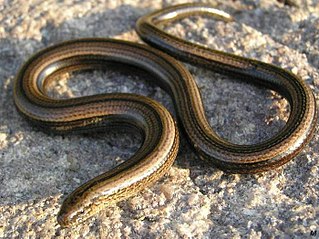
Cordylidae is a family of small- to medium-sized lizards that occur in southern and eastern Africa. They are commonly known as girdled lizards, spinytail lizards, or girdle-tail lizards.

The Chamaesaura, also known as grass lizards, are a genus of legless lizards from southern and eastern Africa. The limbs are reduced to small spikes. Chamaesaura propel themselves like snakes, pushing against contact points in the environment, such as rocks, plants and irregularities in the soil. They are viviparous and eat small invertebrates, especially grasshoppers.

The genus Cordylus includes a wide variety of species of small to medium spiny lizards from Africa, collectively called girdle-tailed lizards or girdled lizards. All are diurnal and ovoviviparous. Most species are rupicolous (rock-dwelling), while a few species are arboreal or live in burrows. They defend themselves with osteoderms and by quickly retreating into rock crevices or burrows. Many species live in groups, and males defend territories.

Legless lizard may refer to any of several groups of lizards that have independently lost limbs or reduced them to the point of being of no use in locomotion. It is the common name for the family Pygopodidae. These lizards are often distinguishable from snakes on the basis of one or more of the following characteristics: possessing eyelids, possessing external ear openings, lack of broad belly scales, notched rather than forked tongue, having two more-or-less-equal lungs, and/or having a very long tail.

The East African armadillo lizard, dwarf sungazer, or tropical girdled lizard is a species of arboreal or rupicolous (rock-dwelling) lizard endemic to East Africa.

The Transvaal grass lizard, also known as the coppery grass lizard and Transvaal snake lizard is a species of lizard in the genus Chamaesaura. It is found in southern African grasslands and on slopes. The Transvaal grass lizard is ovoviviparous. The scientific name refers to its copper colour.

The Cape grass lizard, also known as the Cape snake lizard or the highland grass lizard, is a species of lizard in the genus Chamaesaura. It widely found in southern Africa, inhabiting grasslands. In one of the countries it lives in, Eswatini, it is listed as a Near Threatened species.
The large-scale grass lizard, also known as the large-scaled snake lizard, Zambian grass lizard, or Zambian snake lizard, is a species of lizard in the genus Chamaesaura. It lives scattered across southern Africa with two subspecies.

The rock monitor is a species of monitor lizard in the family Varanidae. The species is endemic to Central, East, and southern Africa. It is the second-longest lizard found on the continent, and the heaviest-bodied; locally, it is called leguaan or likkewaan.
Sauroscaptor is a genus of cistecephalid dicynodont from the upper Permian of India, containing one species, S. tharavati. It is remarkable for the extreme placement of its pineal foramen, which bulges out of the posterior margin of its skull.

Adolfus africanus, also known as the multi-scaled forest lizard or green-bellied forest lizard, is a species of lizard. It has a disjunct distribution in the Central African humid forest zone and is found in Cameroon, the Central African Republic, the Democratic Republic of the Congo, South Sudan, Uganda, Rwanda, western Kenya, and extreme northern Zambia; it seems to be absent from the central Congo Basin. It is associated with primary forests and probably does not tolerate deforestation.
Nucras boulengeri, also known commonly as the Uganda savannah lizard and Boulenger's scrub lizard, is a species of lizard in the family Lacertidae. The species is native to East Africa.
Panaspis seydeli, also known as the Seydel's snake-eyed skink, is a species of lidless skink, a lizard in the family Scincidae. The species is known from the Democratic Republic of the Congo and Zambia.

The black limbless skink is an extant species of skink, a lizard in the family Scincidae. The species is found in Mozambique, Malawi, Zambia, Kenya, Tanzania, and Democratic Republic of the Congo.
Chamaesaura tenuior, the Cape snake lizard, is a species of lizard which is found in the eastern Democratic Republic of the Congo, Uganda, Kenya, and Tanzania.
There are two species of lizard named Cape snake lizard:
Laurent's plated lizard is a species of lizard in the Gerrhosauridae family. It is found in Angola, Democratic Republic of the Congo, and Zambia.
The keeled plated lizard is a species of lizard in the Gerrhosauridae family. It is found in Angola, Democratic Republic of the Congo, Zambia, Namibia, and Botswana.

The black-lined plated lizard is a species of lizard in the Gerrhosauridae family. It is found in Gabon, Democratic Republic of the Congo, Angola, Namibia, Tanzania, Botswana, Malawi, Mozambique, South Africa, Zimbabwe, Kenya, and Zambia.








